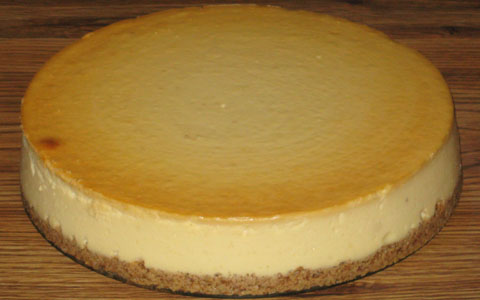|
|
 |
Baked Orange Cheesecake—Prototype 3:
Crust:
1.5 oz. melted, white chocolate
3 tablespoons orange juice
1/2 tablespoon grated orange peel
3 tablespoons sugar
4 oz. lowfat cottage cheese, whipped (such as Hood, no salt added)
Fully blend the above ingredients before adding:
2.2 oz. finely ground Bran Buds
Blend the Bran Buds into the above mixture as quickly as possible and then
pour quickly into a greased springform pan, 9".
Mix thoroughly together:
2 tablespoons butter, softened or melted
1/2 cup sugar
Then blend in:
1/4 cup orange juice
Then mix in:
2 cups (such as a 16-ounce container) of lowfat cottage cheese (such as
Hood, no salt added)—whip this in a blender just until the curds no longer
show, before adding to the above ingredients.
Next add:
1/2 cup skim milk
Follow up gradually with a dry combination of:
1 teaspoon grated orange peel
1/4 cup flour
1/4 teaspoon salt
Completely mix all of the above ingredients used so far, then finally add:
2 eggs (last ingredient here)—aim to get these at least fully mixed in (yet
without overbeating, if possible).
Make sure that the oven is preheated to 300 degrees. If using the bath
approach, have enough boiling hot water available, and fill a large
"tub" with it and place this in the oven, close to halfway up.
Pour the batter into the springform pan. Next, put this pan into the oven.
If using the bath approach, place the springform pan immediately above the
"tub". Bake for about 90 minutes. Afterward, take the springform
pan out of the oven, and let the cheesecake cool off. After it has cooled
down to about room temperature, carefully remove it from the pan, and
refrigerate.
Baked Orange Cheesecake—Prototype 4:
Repeat Prototype 3, but...
Make these changes for the crust:
Boost white chocolate by 1/2 oz., to 2 oz.
Boost orange juice by 1 tablespoon, to 1/4 cup.
Boost sugar by 1 tablespoon, to 1/4 cup.
And make this change for the batter:
Boost grated orange peel by 1 teaspoon, to 2 teaspoons.
Baked Orange Cheesecake—Prototype 5:
Yogurt Cheese:
Prepare ahead of time 3 pounds of yogurt cheese, derived from three 32-ounce
containers of nonfat yogurt. If the resulting yogurt cheese falls below 48
ounces, add back enough of the whey (that was strained out from the yogurt) to
make up the difference.
Crust:
2 oz. melted, white chocolate
1/4 cup orange juice (tip: microwave this juice a little, then add it directly
to the melted white chocolate, and mix thoroughly)
8 oz. (1 cup) yogurt cheese (see above)
5 tablespoons sugar
2 teaspoons grated orange peel
2 oz. All-Bran, ground up
Gently pour this crust mixture into bottom of pan (9 to 9 1/2 inches) and
pre-bake without tub at 300 degrees for 10 minutes, then cool enough to
comfortably touch at least the pan's upper sidewall.
Batter:
4 tablespoons melted or softened butter
1 1/3 cups sugar
1/2 cup orange juice
4 teaspoons grated orange peel
1/4 cup all-purpose flour
3 tablespoons arrowroot
40 oz. (5 cups) yogurt cheese (see above)
2 teaspoons vanilla
4 eggs
Pour the batter over the crust and bake this cheesecake in a tub at 300 degrees
for 100 minutes (if using a 9 1/2" pan). Then cool the cheesecake down
while still in oven (with this oven shut off) and in tub with door slightly ajar
for an hour. Afterwards, remove from oven and tub and continue to cool down at
room temperature for another 100 minutes, then remove from pan and refrigerate.

|
|

|

